LESSON 10
CREATION V EVOLUTION ii
5. The age of the earth
Evolutionists use one key idea in order to come to the conclusion that the earth is very old (and, therefore, the Bible is not a true history of the world), called uniformitarianism.
Uniformitarianism is the assumption that the same natural laws and processes that operate in the world today have always operated in the past. In other words, “the present is the key to the past” and all physical processes are functioning at exactly the same rates. For example, the rivers we see flowing today have been there for millions of years looking just the same as we observe them today. Uniformitarianism is an essential principle of geology.
Note that an assumption is a belief, it is not something you can prove. You use the belief as the foundation to your understanding.
For example, consider the Grand Canyon and the Colorado River that flows through it:
 The Grand Canyon is 446 km long, up to 29 km wide and attains a depth of over a 1.8 km. In the Canyon walls we can observe many different layers of sedimentary rock (i.e. rock formed by particles carried and laid down by fast-moving water) on top of layers of bedrock made up of igneous and metamorphic rock (igneous rock is formed by volcanic activity; metamorphic rock is formed by heat and pressure that alters the chemical composition of the original material). The Grand Canyon is 446 km long, up to 29 km wide and attains a depth of over a 1.8 km. In the Canyon walls we can observe many different layers of sedimentary rock (i.e. rock formed by particles carried and laid down by fast-moving water) on top of layers of bedrock made up of igneous and metamorphic rock (igneous rock is formed by volcanic activity; metamorphic rock is formed by heat and pressure that alters the chemical composition of the original material).
|
Evolutionists look at the Grand Canyon as it is today and conclude that the Colorado river that flows through it eroded the Canyon over a vast period of time – 17 million years. The layers of sedimentary rock it cuts through were laid down, so they conjecture, over many millions of years before the river began its slow process of gradual erosion. Remember this is using the present as the key to understand the past. Can they prove that this is in fact what happened? NO! They have to use the assumption of uniformitarianism to come up with the date. (They also employ dating techniques for rocks discussed later – these methods also require the assumption of uniformitarianism.)
Creationists also use an assumption to understand the age of the earth and the geological features we observe today.
Creationism is the assumption that the Bible’s historical account is true. Therefore, the earth (and the universe) was created by God around 6000 years ago, and the geological features we observe today are predominantly the result of the cataclysmic world-wide flood that occurred around 4400 years ago.
Creationists look at the Grand Canyon today and conclude the Colorado river did not form the Canyon (i.e. a little amount of water over a long period of time). But rather it is the result of a large volume of water that flowed off the North American continent as the flood waters receded into the sea basins around 4400 years ago, cutting into the layers of sedimentary rock that had been formed during the flood (i.e. a large amount of water over a small period of time). Therefore, the Canyon did not form slowly, but very very quickly.
Can creationists prove that this is in fact what happened? NO! They have to use the assumption to come up with the date.
Nevertheless, we can look at the evidence to see if the evolutionist or creationist viewpoint is more probable.
Here are six pieces of evidence from the Grand Canyon:[1]
Evidence 1 Fossils of sea creatures high above sea level
Most of the rock layers in the walls of Grand Canyon (more than a 1.6km above sea level) contain marine fossils. (Fossils of sea creatures are found in rock layers that cover all the continents.) How did sea creatures, i.e. creatures that don’t live in fresh water like the present river, get there?
Evidence 2 Rapid burial of animals
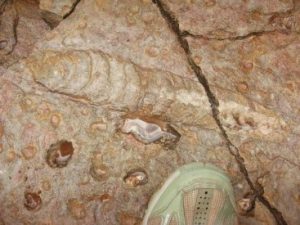 Billions of nautiloid fossils are found in a layer within the Redwall Limestone of Grand Canyon. This layer was deposited catastrophically by a massive flow of sediment (mostly lime sand). Many of the nautiloid fossils (1 in 7) are standing vertically.
Billions of nautiloid fossils are found in a layer within the Redwall Limestone of Grand Canyon. This layer was deposited catastrophically by a massive flow of sediment (mostly lime sand). Many of the nautiloid fossils (1 in 7) are standing vertically.
Evidence 3 Rapidly deposited sediment layers spread across vast areas
Rock layers can be traced all the way across continents—even between continents—and physical features in those strata indicate they were deposited rapidly. For example, the Tapeats Sandstone and Redwall Limestone of Grand Canyon can be traced across the entire United States, into Canada and across the Atlantic Ocean to England. Inclined (sloping) layers within the Coconino Sandstone of Grand Canyon are testimony to 10,000 cubic miles of sand being deposited by huge water currents within days.
Evidence 4 Sediment transported long distances
Sediments in those widespread, rapidly deposited rock layers had to be eroded from distant sources and carried long distances by fast-moving water. For example, the sand for the Coconino Sandstone of Grand Canyon (Arizona) had to be eroded and transported from the northern portion of what is now the United States and Canada. Furthermore, water current indicators (such as ripple marks) preserved in rock layers show that water currents were consistently flowing from northeast to southwest across all of North and South America, which, of course, is only possible over weeks during a global Flood (not slowly over 300 million years projected by evolutionists).
Evidence 5 Rapid or no erosion between strata
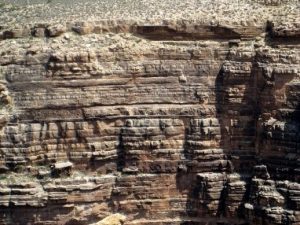
 Flat, knife-edge boundaries between rock layers indicate continuous deposition of one layer after another, with no time for erosion. For example, there is no evidence of any “missing” millions of years (of erosion) in the flat boundary between two well-known layers of Grand Canyon—the Coconino Sandstone and the Hermit Formation. Another impressive example of flat boundaries at Grand Canyon is the Redwall Limestone and the strata beneath it. The different layers must have been laid down immediately, one on top of the other.
Flat, knife-edge boundaries between rock layers indicate continuous deposition of one layer after another, with no time for erosion. For example, there is no evidence of any “missing” millions of years (of erosion) in the flat boundary between two well-known layers of Grand Canyon—the Coconino Sandstone and the Hermit Formation. Another impressive example of flat boundaries at Grand Canyon is the Redwall Limestone and the strata beneath it. The different layers must have been laid down immediately, one on top of the other.
Evidence 6 Many strata laid down in rapid succession
Rocks do not normally bend; they break because they are hard and brittle. But in many places we find whole sequences of strata that were bent without fracturing, indicating that all the rock layers were rapidly deposited and folded while still wet and pliable before final hardening. For example, the Tapeats Sandstone in Grand Canyon is folded at a right angle (90°) without evidence of breaking. Yet this folding could only have occurred after the rest of the layers had been deposited, supposedly over “480 million years,” while the Tapeats Sandstone remained wet and pliable! Just impossible.
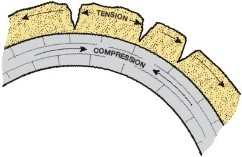
![]() Rock strata should crack if hard when bent
Rock strata should crack if hard when bent
…………but…………..
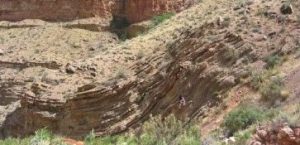
this is what we find all over the world – folding without cracking ![]()
Conclusion: The evolutionists story of vast ages just does not fit the evidence presented by the Grand Canyon. On the other hand, the Bibles’ account of a world-wide flood explains the evidence perfectly.
Mount St Helens: evidence of rapid formation of rock strata and canyon erosion
A recent example of rapid formation and erosion is the eruption of Mount St Helens (in the North West of North America). It vividly demonstrated the power of catastrophe to rapidly change the geologic features of the earth even on a relative minor scale.
 before eruptions before eruptions |
after eruptions  |
On the morning of May 18, 1980, an earthquake measuring 5.1 on the Richter scale causing the northern slope of the mountain to fracture. Magma and gases that had been trapped inside the mountain under pressure exploded, entirely ripping away the north side of the volcano. The debris from the explosion cascaded down the mountain as a huge landslide reaching speeds of over 240 km/h. Over 395m of the summit and northern slope were torn away and thrown over 590 square kilometres of the surrounding area. A section of a nearby river was buried to an average depth of 45m and up to 180m at its highest point.
pressure exploded, entirely ripping away the north side of the volcano. The debris from the explosion cascaded down the mountain as a huge landslide reaching speeds of over 240 km/h. Over 395m of the summit and northern slope were torn away and thrown over 590 square kilometres of the surrounding area. A section of a nearby river was buried to an average depth of 45m and up to 180m at its highest point.
As the land slid away, molten rock at temperatures of 925°C exploded water into steam and resulted in a shock wave of terrific force to blast out over the northern landscape at a speed of 1,040 km/h. Within seconds, 515 square kilometres of forests was destroyed literally ripping trees out of the ground closest to the blast and tossing them around like toothpicks, flattening others farther away and stripping the leaves and limbs off those furthest away from the blast. The melted snow and ice from the blast created mudflows picking up rocks and trees and flowed at the rate of 145 km/h over the land and into the river channels.
On May 19, 1982, another eruption of Mount St. Helens melted the thick snow in the newly formed crater, causing a destructive, sheet-like flood of water which became a mudflow. Bedrock was eroded up to 180m deep to form two canyons on the northern side of the volcano. Reaching the former landslide and eruption debris deposits the flow formed channels cutting further canyons up to 42m deep. The erosion left elevated plateaus to the north and south resembling the Grand Canyon.
deep to form two canyons on the northern side of the volcano. Reaching the former landslide and eruption debris deposits the flow formed channels cutting further canyons up to 42m deep. The erosion left elevated plateaus to the north and south resembling the Grand Canyon.
The eruptions of Mount St. Helens clearly testify that the following geological features do not require long ages to form:
Fine layering was produced within hours on 1980 by hurricane velocity surging flows from the crater of the volcano. Upon which is a 7.6m thick seam formed by the debris deposit in the middle of the cliff. It is overlain by the massive, but thinner 1982 mudflow deposit, and is underlain by the air-fall debris from the last hours of the 1980. http://www.answersingenesis.org/articles/2010/05/18/thirtieth-anniversary-of-geologic-catastrophe overlain by the massive, but thinner 1982 mudflow deposit, and is underlain by the air-fall debris from the last hours of the 1980. http://www.answersingenesis.org/articles/2010/05/18/thirtieth-anniversary-of-geologic-catastrophe |
Layers of sediment: Up to 183m of strata was formed. Many of these layers formed as debris slid down the side of the volcano and as mudflows and pyroclastic flows (volcanic ash, rock fragments and hot gases) enveloped the surrounding land, adding layer upon layer upon layer.
 Canyon formation: A canyon was formed cutting through 180m of bedrock and forming a canyon over 46m deep in a single day. It is described by some as looking like a ‘mini Grand Canyon’.
Canyon formation: A canyon was formed cutting through 180m of bedrock and forming a canyon over 46m deep in a single day. It is described by some as looking like a ‘mini Grand Canyon’.
Formation of Coal: Coal forms from organic materials which first appears as peat. The composition of the peat found on the bottom of Spirit Lake is similar to many coal beds in parts of the United States. Moreover, trees trunks that were floating on the surface of the lake after a period of time tipped vertically and then sunk in the upright position to the bottom of the lake! Again mimicking the tree trunks that appear rising vertically through coal seams.



The Mount St Helens explosion showed that rock layers, canyons and coal could all be formed rapidly under catastrophic conditions and are not necessarily formed over millions of years as claimed by evolutionists. The eruption provides some indication of what took place during the worldwide Flood around 4,500 years ago.
Evidences for a young earth[2]
If the Bible is true and the earth is around 6000 years old, there should be many evidences that the earth is young. And there are many we discover that point to this fact. Remember, we confidently date the earth and universe to be 6000 years according to the Bible’s time-frame. We believe what the Bible says about the earth’s history to interpret what we observe.
However, we can obtain different ‘dates’ for the age of the earth and the universe using evolutionists own assumption of uniformitarianism by taking present observed rates and projecting back into the past to obtain maximum possible ages. By evolutionists own reasoning we can prove that the earth is much younger than what they say it is. Here are a few examples:
- Erosion of continents – maximum possible age 10 million years
- Too few supernova remnants – maximum age 7,000 years
- Comet life – maximum age 10,000 years
- Salt in seas – maximum age 62 million years
- Mud on sea floors – maximum age 12 million years
- Earth’s magnetic field – maximum age 20,000 years
- Soft tissue and blood cells found in dinosaur fossils – maximum age 10,000 years
- Human population too small – maximum age 4,500 years
On this evidence alone, science shows us that vast ages are impossible based upon the (false) assumption of uniformitarianism. Present processes we observe in the world today, could not have continued for the millions of years claimed by evolutionists. All of the mountains on the earth would have been eroded flat a very long time ago; the seas would be clogged with silt and nothing would live in them because of the high salt content; and, the population of the world would be in the 100s of billions not the present 6 billion!
Furthermore, many things we observe in the world, which are claimed by scientists to have been produced by processes over long ages, can be produced rapidly in a short time span given the right conditions, including
- Coal
- Oil
- Fossils
- Stalactites and stalagmites
- Opals
- Diamonds
- Rocks
- Coral reefs

This picture was taken in a man-made tunnel, a lead-zinc mine, in Queensland Australia. The mine was 55 years old when the picture was taken. These stalactites and stalagmites clearly did not take 100s of thousands of years to form. |
Evolutionists claim that all of these things formed gradually over long periods of time. But their claims are built upon false assumptions.
|
|
Radio-active dating techniques[3]
Many people believe that scientists have proved the earth to be billions of years old, because they have radio-active techniques to date rocks. But this is not true. There is no absolute age-dating method to determine exactly how old the earth is.
Here are the facts:
- All dating methods are based upon the following assumptions:
- amount of ‘parent’ and ‘daughter’ chemical present normally 100% and 0%
 An hourglass ‘clock’ tells us the elapsed time by comparing the amount of sand in the top bowl (‘Parent’) with the amount in the bottom bowl (‘Daughter’). An hourglass ‘clock’ tells us the elapsed time by comparing the amount of sand in the top bowl (‘Parent’) with the amount in the bottom bowl (‘Daughter’).
|
- no leaching of chemicals by water in or out of the rock
- decay rates have remained unchanged
None of these things can be assumed with certainty. Change the assumptions and you change the dates. Radiometric ‘dating’ labs do not measure age – they measure amounts of chemicals, then they infer the age, based upon the assumptions.
- When the dating methods are tested against rocks of known age – eg recent lava flow – they often fail miserably.
- Objects of the same age, tested by different methods, have given wildly varying ‘dates’.
- The entire geological ‘millions of years’ system was in place before radioactivity was discovered. When radiometric techniques contradict the system – e.g. when a fossil provides a different age – the radiometric date is always discarded.
Here are open admissions from two evolutionists concerning the unreliability of the dating methods:
“It is obvious that radiometric techniques may not be the absolute dating methods that they are claimed to be. Age estimates on a given geological stratum by different radiometric methods are often quite different (sometimes by hundreds of millions of years). There is no absolutely reliable long-term radiological ‘clock’.”
William Stansfield, Ph.D., California Polytech State
“The age of our globe is presently thought to be some 4.5 billion years, based on radio-decay rates of uranium and thorium. Such ‘confirmation’ may be shortlived, as nature is not to be discovered quite so easily. There has been in recent years the horrible realization that radio-decay rates are not as constant as previously thought, nor are they immune to environmental influences. And this could mean that the atomic clocks are reset during some global disaster, and events which brought the Mesozoic to a close may not be 65 million years ago, but rather, within the age and memory of man.”
Frederick B. Jueneman
Evolutionists claim diamonds are 1-3 billion years old. However, carbon-14 has been found in diamonds proving they are at most thousands of years old!  |
Regarding Carbon-14 dating, this method is, at best, only useful for estimating the age of things that are thousands of years old, not millions or billions. And it does not work on rocks or thoroughly mineralized fossils; it is only useful for relatively well-preserved organic materials such as cloth, wood, and other non-fossilized materials. (Other methods must be used to estimate the age of rocks and minerals.)
6. Evidence of Design
If the creation account in the book of Genesis is true, then we should expect to find evidence of incredible intelligence in the design of the universe and all living things. Design points to an intelligent designer! The fact is that nature has design written all over it.
If you were walking along a deserted beach and came across a sand and rock formation that you could read and recognize, for example ‘John loves Jane’ with stones placed in the shape of a heart around these words, you would immediately know that someone, some intelligence, had done that. It would be impossible for the action of wind and waves to produce that result. Even given tens of millions of years it would be impossible because intelligent information does not arise by random processes of time and chance. We would know that someone had written and formed that shape in the sand, because we recognize information from an intelligent source. In other words, design requires a designer.
You may have been taught that given enough time, monkeys typing randomly on a computer could create one of Shakespeare’s plays. In other words, order can arise from chaos, design will eventually arise; we just need time. This example is used by evolutionists to justify the idea that given enough time, a worm can turn into a weasel and then into a woman. However, this is a lie. It is absolutely impossible. We regard the story of a girl kissing a frog which turns into a prince as a fairy-tale. All evolutionists do is add a big space of time in between. But it remains a fairy-tale.
Russell Grigg, a creation scientist, explains:
“Let us imagine a special typewriter, ‘user-friendly’ to apes, with 50 keys, comprised of 26 capital letters, 10 numbers, one space bar, and 13 symbols for punctuation, etc. For the sake of simplicity we shall disregard lower-case letters and settle for typing all to be in capitals, and we shall disregard leap years.
How long would it take an operator, on the average, to correctly type the 23rd Psalm, by randomly striking keys? To obtain the answer, let us first consider the first verse of the Psalm, which reads: ‘THE LORD IS MY SHEPHERD, I SHALL NOT WANT.’
According to the Multiplication Rule of Probability (in simplified form) the chance of correctly typing the three designated letters ‘THE’ from possibilities is 1 in 50 x 50 x 50, which equals 125,000. At a rate of one strike per second, the average time taken to make 125,000 strikes is 34.72 hours.
The chance of randomly typing the eight keys (seven letters and one space) in the right sequence for the two words THE LORD is 1 in 50 x 50 … eight times (i.e. 508). This is 1 chance in 39,062 billion. There are 31,536,000 seconds in a year, so the average time taken in years to make 39,062 billion strikes at the rate of one strike per second would be 1,238,663.7 years.
The time taken on the average to correctly type the whole of verse 1 of the 23rd Psalm, which contains 42 letters, punctuation, and spaces, would be 5042 divided by 31,536,000 (seconds in a year), which is 7.2 x 1063 years.
And the time taken on the average to correctly type the whole of the 23rd Psalm, made up of 603 letters, verse numbers, punctuation, and spaces, would be 50603 divided by 31,536,000 which is 9.552 x 101016 years.4 If the letter ‘b’ stands for billion (109), this could be written as about one
bbbbbbbbbbbbbbbbbbbbbbbbbbbbbbbbbbbbbbbbbbbbbbbbbbbbbbbbb
bbbbbbbbbbbbbbbbbbbbbbbbbbbbbbbbbbbbbbbbbbbbbbbbbbbbbbb years.
By comparison, the evolutionists’ age of the Earth is (only) 4.6 billion years, and the evolutionists’ age of the universe is (only) almost 15 billion years.”[4] (That evolutionary time-frame is represented by just a 4,6 and a 15 in front of one “b”. That is tiny compared even to just “bb”!)
Moreover, every one of Shakespeare’s plays is much longer than the 23rd Psalm. The numbers are that much bigger again.
The late Sir Fred Hoyle , who was Professor of Astronomy at Cambridge University and was not a Christian, used the following example to explain the probability of producing even just one of the ‘biopolymers’, i.e. proteins, necessary for life:
“Now imagine 1050 blind persons [that’s 100,000 billion billion billion billion billion people standing shoulder to shoulder – they would more than fill our entire planetary system] each with a scrambled Rubik cube and try to conceive of the chance of them all simultaneously arriving at the solved form. You then have the chance of arriving by random shuffling [random variation] of just one of the many biopolymers on which life depends. The notion that not only the biopolymers but the operating program of a living cell could be arrived at by chance in a primordial soup here on Earth is evidently nonsense of a high order.”
Another of Professor Hoyle’s analogies of the chance that even the simplest self-reproducing life forms might have emerged by evolutionary processes is comparable with the chance that “a tornado sweeping through a junk-yard might assemble a Boeing 747 from the materials therein.”
The theory of evolution utterly fails because the mechanism of time and chance cannot possibly produce the order and design we find in life.
Irreducible complexity
Another major insurmountable problem that strikes down the theory of evolution is that living things contain features of different parts all working together. If one part is missing, the whole system fails. This is called ‘irreducible complexity’.
Irreducible complexity demonstrates that God created all of the different components necessary for life all together, in every living thing in an instant, otherwise life could not exist.
Evolution proposes that, for example, the eye could have been formed by time and chance producing each element of the eye gradually piece by piece until it was fully functional. Darwin himself admitted:
“To suppose that the eye with all its inimitable contrivances for adjusting the focus to different distances, for admitting different amounts of light, and for the correction of spherical and chromatic aberration, could have been formed by natural selection, seems, I freely confess, absurd in the highest degree.”
Darwin went on to propose how it might have been achieved, however, his ideas are fiction not fact. The lens, the eyeball, the retina, the entire optical system, the connections to the brain etc, must function together as an integrated unit for the eye to see. If any one of those components is missing or defective, sight would be impossible. The evolution of the eye has been debated ever since Darwin and is still being debated among evolutionists. (The biggest problem they have is that a complex eye appears in the supposedly earliest life-forms, the trilobite. There is not even any hint of any suggestion of some line of development in creatures existing before trilobites with primitive eyes leading up to the trilobite.)
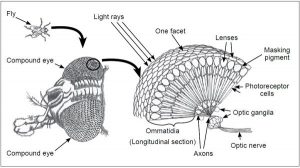
The compound eye of an insect. Note that the eye consists of hundreds or more separate eyes, which is more complex than the human eye. |
A mousetrap is a good but non-living and simple example of irreducible complexity. Five basic parts of the trap must work together in order for it to catch mice:
(1) a flat wooden base
(2) a spring
(3) a sensitive catch that releases when pressure is applied
(4) a bar that connects to the catch and holds the hammer under tension
(5) the hammer that despatches the mouse.
A mousetrap needs each of these parts to kill a mouse. Each part works interdependently, and so a partially constructed mousetrap serves no function and is worthless.
This is a simple example. For living things it is exceedingly more complex and more amazing.
Michael Behe, who first used the expression ‘irreducible complexity’, gives the example of what enables many types of microscopic bacteria – single-cell living organisms – to propel themselves called the “flagellum”. It is like a motor with a shaft and propeller which spins creating forward (and backwards) motion. Behe explains:
“Just picture an outboard motor on a boat and you get a pretty good picture of how the flagellum functions, only the flagellum is far more incredible. The flagellum’s propeller is long and whip-like, made out of a protein called flagellin. This is attached to a drive shaft by hook protein, which acts as a universal joint, allowing the propeller and drive shaft to rotate freely. Several types of protein act as bushing material (like washer/donut) to allow the drive shaft to penetrate the bacterial wall (like the side of a boat) and attach to a rotary motor. … Not only that but the propeller can stop spinning within a quarter turn and instantly start spinning the other direction at 10,000 rpms.[5]
protein called flagellin. This is attached to a drive shaft by hook protein, which acts as a universal joint, allowing the propeller and drive shaft to rotate freely. Several types of protein act as bushing material (like washer/donut) to allow the drive shaft to penetrate the bacterial wall (like the side of a boat) and attach to a rotary motor. … Not only that but the propeller can stop spinning within a quarter turn and instantly start spinning the other direction at 10,000 rpms.[5]
The flagellum molecular motor requires 20 protein structures, all working together perfectly in order to function. Like the mousetrap, the flagellum would be useless and the bacterium would die if any one of those 20 protein structures was missing or undeveloped. Again it demonstrates that even for very simple forms of life, single-cell bacteria, the structures and systems we find in them require that they be perfectly formed from the very beginning in order for that living organism to survive. It is impossible that bits and pieces developed gradually over time, and eventually came together in a functioning structure. Evolution is both improbable and impossible.
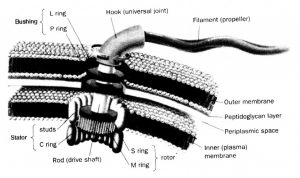
Darwin himself conceded that: “If it could be demonstrated that any complex organ existed which could not possibly have been formed by numerous, successive, slight modifications, my theory would absolutely break down.” Michael Denton, who is not a Christian, writes that the claim that Darwinian gradualism: “can generate the sorts of complex systems we see throughout the biosphere is not only unsubstantiated, but in many cases it is actually beyond the realm of common sense that such things would ever happen”.
WHAT ABOUT MUTATION? DON’T THEY PROVE THAT EVOLUTION IS POSSIBLE?
MichaeL Denton wrote the “essential bedrock of Darwinism” is the belief that “all the organisms which have ever existed throughout history were generated by the accumulation of entirely undirected mutations …. That is an entirely unsubstantiated belief for which there is not the slightest evidence whatsoever.”
Observed mutations are only always negative, i.e. they produce a loss of information, never a gain in information. Creatures are badly deformed and impaired if there are errors in their dna. For simple organisms to evolve into more complex organisms there must be a gain of additional information in a cell’s dna. There is no mechanism to produce a gain in information. God created every living creature with its own set of instructions, its dna, in the very beginning, in order to reproduce after its own kind. And this is exactly what we observe.
There is a huge number of highly complex systems in nature which cannot be plausibly accounted for in terms of a gradual build-up of small random mutations. We could fill a library giving details of these systems. Here is a sample:
The Amazing Bombardier Beetle!
http://www.answersingenesis.org/articles/cm/v12/n1/amazing-bombardier-beetle
“The tiny bombardier beetle could not possibly have evolved. His defence mechanism is amazingly complicated, and could only have been created with all the parts working together perfectly. From twin ‘exhaust tubes’ at his tail, this beetle fires into the face of his enemies boiling-hot noxious gases with a loud pop.
“How can this be? German chemist Dr Schildknecht discovered that the beetle mixes two chemicals (hydrogen peroxide and hydroquinone) which would usually form a dirty ugly mixture. The well-designed beetle uses a special ‘inhibitor’ chemical to keep the mixture from reacting. How then can the explosion instantaneously occur when needed?
uses a special ‘inhibitor’ chemical to keep the mixture from reacting. How then can the explosion instantaneously occur when needed?
“Dr Schildknecht discovered that in the beetle’s specially designed combustion tubes are two enzymes called catalase and peroxidase which make chemical reactions go millions of times faster. These chemicals catalyze the extremely rapid decomposition of hydrogen peroxide into water and oxygen and the oxidation of hydroquinone into quinone, causing them to violently react and explode — but not so soon as to blow up the beetle, of course!
“Common sense tells us that this amazing little insect cannon which can fire four or five ‘bombs’ in succession could not have evolved piece by piece. Explosive chemicals, inhibitor, enzymes, glands, combustion tubes, sensory communication, muscles to direct the combustion tubes and reflex nervous systems – all had to work perfectly the very first time – or all hopes for ‘Bomby’ and his children would have exploded!”
The Amazing Giraffe
http://www.creationism.org/articles/giraffes.htm
“With the head being so high in the air, the huge heart of the giraffe must be capable of delivering sufficient oxygen-rich blood three metres (10 feet) up to the brain. This would be a problem (involving too high blood pressure) when the giraffe was head-down drinking water, were it not for a unique collection of reinforced artery walls, by-pass and antipooling valves, a web of small blood vessels (the rete mirabile, or ‘marvellous net’) and pressure-sensing signals that keep adequate blood flow to the brain at just the right pressure. Even to those who consider this as just ‘adaptation to high gravitational pressures in its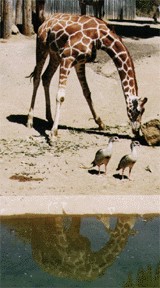 cardiovascular system’, the giraffe is unique.
cardiovascular system’, the giraffe is unique.
“The giraffe’s heart is probably the most powerful among animals, because about double normal pressure is required to pump blood up the giraffe’s long neck to the brain. With such high blood pressure, only special design features prevent it from ‘blowing its mind’ when it bends down to take a drink.
“Equally marvellous is the fact the blood does not pool in the legs, and a giraffe does not bleed profusely if cut on the leg. The secret lies in an extremely tough skin and an inner fascia that prevents blood pooling. This skin combination has been studied extensively by NASA scientists in their development of gravity-suits for astronauts. Equally helpful to prevent profuse bleeding is that all arteries and veins in the giraffe’s legs are very internal.
“The capillaries that reach the surface are extremely small, and the red blood cells are about one-third the size of their human counterparts, making capillary passage possible. It quickly becomes apparent that these unique facets of the giraffe are all interactive and interdependent with its long neck.
“But there’s more. The smaller red blood cells allow for more surface area and a higher and faster absorption of oxygen into the blood. This helps to retain adequate oxygen to all extremities, including the head.
“The lungs work in conjunction with the heart to supply the giraffe with the necessary oxygen, but in a way that is unique to the giraffe. The giraffe’s lungs are eight times the size of those of humans, and its respiratory rate is about one-third that of humans. Breathing more slowly is necessary in order to exchange the required large volume of air without causing windburn to the giraffe’s rippled 3.6 metres (12 feet) of trachea. When the animal takes in a fresh breath, the oxygen-depleted previous breath cannot be totally expelled. For the giraffe this problem is compounded by the long trachea that will retain more dead air than man can inhale in one breath. There must be enough lung volume to make this ‘bad air’ a small percentage of the total.”
The Incredible Woodpecker
http://www.christianbirding.org/start/christianbirding/articles/A_IncredibleWoodpecker.htm
 “The woodpecker is very specially constructed, exhibiting design and purpose. So unique is the woodpecker that it is difficult to accept that it is the product of purposeless evolutionary forces. In fact, study the woodpecker carefully and you find evidence that points to its being wonderfully designed by God the Creator.
“The woodpecker is very specially constructed, exhibiting design and purpose. So unique is the woodpecker that it is difficult to accept that it is the product of purposeless evolutionary forces. In fact, study the woodpecker carefully and you find evidence that points to its being wonderfully designed by God the Creator.
“Woodpeckers spend most of their time spiralling up tree trunks searching for insects. When a woodpecker has searched one tree it flies to the base of the next and repeats the operation. Its ability to climb vertical trunks and to maintain its position while pecking the tree is because it has been designed with two backward-facing toes and an associated arrangement of tendons and leg muscles, sharp claws, and stiff tail feathers tipped with spines which are used as a prop while climbing. It also has exceptionally strong flight.
“Because of the energy they expend, woodpeckers are very hungry birds. A black woodpecker, a native of North America, for example, can eat 900 beetle larvae or 1,000 ants at a single sitting; a green woodpecker may eat up to 2,000 ants in one day. This seemingly insatiable appetite has a purpose, for woodpeckers are valuable in the control of insects, even helping to limit the spread of tree diseases, such as Dutch elm disease, by destroying insect carriers. This plays great importance in preserving many of the world’s forests.
“To find its food, a woodpecker hammers wood at the rate of 15 to 16 times a second—a ‘rate of fire’ nearly twice as fast as a submachine gun.
“The forces involved in the woodpecker’s hammering away at trees are incredible, for the suddenness with which the head is brought to a halt during each peck results in a stress equivalent to 1,000 times the force of gravity. This is more than 250 times the force to which an astronaut is subjected in a rocket during liftoff!
“How is the woodpecker able to withstand such forces? What prevents woodpeckers from beating out their brains?
“The woodpecker survives this head-bashing and these exceptional forces because God in His wisdom has designed the head, beak, and neck in a special way.
“For starters, the Creator has greatly reinforced the woodpecker’s skull with bone. This is necessary if the head is not going to break into pieces. He has given the woodpecker a stronger bill than most birds. It must be strong enough to dig into a tree without folding up like an accordion. The bill is chisel-tipped, and when the woodpecker is chiselling away there is a lot of sawdust. Normally in birds, the sawdust would enter the nostrils, but the woodpecker has been designed with slit-like nostrils covered by fine wiry feathers to prevent the sawdust from entering.
“Also, the beak and brain itself have been cushioned against impact. In most birds, the bones of the beak are joined to the bones of the cranium—the part of the skull that surrounds the brain. But in the woodpecker the cranium and beak are separated by a sponge-like tissue that takes the shock each time the bird strikes its beak against a tree. The woodpecker’s shock-absorber is so good that scientists say it is far better than any that humans have invented.
“For added protection to its brain, the woodpecker has special muscles which pull its brain-case away from its beak every time it strikes a blow. But this is only part of the story. If the woodpecker’s head were to twist even slightly while hammering the tree, the rotation of its head, combined with the force of pecking, would tear away the bird’s brain. But God, the ultimate Designer, has created the woodpecker with superbly co-ordinated neck muscles to keep its head perfectly straight. Thus the bird can withstand the enormous shock it inflicts on itself year in, year out, many thousands of times a day.
“Added to the uniquely designed neck muscles, shock-absorbers, head, and the other amazing aspects of the woodpecker, there is the unique tongue. The typical woodpecker, after flaking off bark and drilling a hole in wood to expose insect tunnels, uses its long tongue to reach deep into the tree to retrieve insects and larvae. Without the long tongue, there is no way the woodpecker could retrieve the insects.
“To help capture the insects, the long tongue has been specially designed with glands that secrete a sticky substance. The insects and worms stick to this long tongue like flies to fly-paper.
“How does the woodpecker know it has caught the insects? The Creator has given it a tongue with a hard spearhead with bristles pointing rearward, which is attached by tiny fibres of the protein collagen. As the tongue probes a tunnel, the impact of the spearhead on any object jams the head back along the shaft. Nerve endings are precisely located in the fluid-filled spaces between the collagen fibres. They provide the brain with information about the type of material contacted; thus, the woodpecker knows whether it has secured an insect or hit the hard wood of a tree. Once the insects stick to its tongue, the woodpecker pulls them from the tree, then pulls in its long tongue and scrapes the insects off into its mouth.
“Where does the woodpecker hold such a long tongue when it is not in use? It cannot just roll it up and store it in its beak, for there isn’t room. The Creator has provided a unique solution to this problem. The tongue of an ordinary bird is anchored in the back of its beak, but this will not work for the woodpecker, because its tongue is too long. Therefore, the tongue of the woodpecker is anchored in the right nostril. After it emerges from the right nostril, it splits into two halves. Each half passes over one side of the skull underneath the skin, comes around and up underneath the beak, and enters through a hole in the beak. Here the two halves combine. Thus, when the woodpecker is not using his long tongue, he rolls it up and stores it in the right nostril.
“Evolutionists would like us to believe that the woodpecker’s uniquely designed toes, stiff tail, strong flight, head, beak, neck muscles, shock-absorbers and tongue are the result of its evolving slowly over many millions of years. Instead, the design of the woodpecker presents a great problem to those who believe in evolution.
“First, how could the woodpecker have evolved its special shock-absorbers? If it had started without them, then all the woodpeckers that were alive would have beaten out their brains long ago. Therefore, there should be no woodpeckers left. And if there had ever been a time when woodpeckers did not drill holes in trees they would not have needed the shock-absorbers anyway.
“Second, how could the unique arrangement for the woodpecker’s tongue have evolved, if, in the beginning, its tongue was anchored in the back of the beak, as it is in ordinary birds? How did the tongue manage to move into the right nostril? If the anchor suddenly hopped from the back of the beak up into the right nostril, the tongue would be too short. And during all the intermediate stages, would the tongue have been long enough to reach the insects and worms inside a tree so the woodpecker could eat and survive?
“To look at it from another angle, suppose a bird developed a long tongue anchored in the right nostril, but he did not develop a strong beak, or powerful neck muscles, the shock-absorbers, and so on. What possible use could such a bird make of the long tongue without the other apparatus employed by the woodpecker? On the other hand, suppose a bird developed all that special apparatus needed to drill a hole in a tree, but not the long tongue. He would drill a hole in a tree in anticipation of a meal of insects, but would not be able to reach the insects. Nothing works here until everything works.
“Design is evident in the woodpecker, but the fossil record is another problem for those who believe woodpeckers have evolved. Fossil woodpeckers are virtually unknown, so the alleged gradual development of lower bird life into the more complex woodpecker over many millions of years cannot be traced in the fossil record. Many fossils claimed long ago as early woodpeckers have now been rejected or called into question.
“The woodpecker must have had all its special designs right from the start to survive all that head-bashing. And this means it must have been created intact, as the Book of Genesis says birds were. It could not have come into existence by the slow and cruel process of evolution.
“The woodpecker simply did not, and could not, have evolved. It is truly an incredibly designed bird, and strong evidence of God’s creation.”
-
The Earth’s Population
(Adapted from the article “Where are all the people?” by Don Batten http://creation.com/where-are-all-the-people)
There are six billion people alive on Earth today. That is not as many people as you may think for the size of our planet. They could all fit into England, with more than 20 square metres for each person! Most people have chosen to live in cities, so there is the impression that the world is overpopulated. However, much of the world – even large tracts of arable land, not just mountainous regions and deserts – is sparsely populated.
Is it possible that the population could have grown to six billion from Noah’s family who survived the Flood that wiped out everyone else about 4,500 years ago? When you do the figures, it confirms the biblical truth that everyone on Earth today is a descendant of Noah’s three sons and their wives. Not only that, but if people have been here for much longer, and there was no global Flood of Noah’s day, there should be a great many more people alive today than there are, and there should be a lot more human graves!
What causes population growth?
The population grows when more people are born than die. (To just keep a constant population each woman needs to produce more than 2 babies because some babies and children die before reaching maturity – the world figure is 2.33, i.e. for every 100 women 233 babies must be born.)
The current growth rate of the world population is about 1.1% per year (it peaked at 2% in the 60’s during the post-war baby boom). In other words, for every 100 million people, 1.1 million are added every year; i.e. extra births above those to replace deaths. In total, the world’s population is growing at present by around 65 million each year.
| Birth Rate | Death Rate |
| 131.4 million births per year | 55.3 million people die each year |
| 360,000 births per day | 151,600 people die each day |
| 15,000 births each hour | 6,316 people die each hour |
Population growth in a number of South American and African countries (which don’t have the medical care that rich nations are able to provide) exceeds 3% per year. In many industrialized countries, the population growth is less than 0.5%. Some relatively wealthy countries are actually declining in population (excluding immigration) – the number of babies born are less than the number of people that die – these include most countries in Europe, Japan and the United States.
What growth rate is needed to get six billion people since the Flood?
It is relatively easy to calculate the growth rate needed to get today’s population from Noah’s three sons and their wives, after the Flood. With the Flood around 4,500 years ago, it needs less than 0.5% per year growth. That’s not a very big figure; it is very possible (compare that with the current 1.1%).
However, the Bible shows from Genesis chapters 10 and 11 that the population grew quite quickly in the years immediately after the Flood. The three sons of Noah are recorded as having the following sons: Shem had five sons, Ham had four, and Japheth had seven. If we assume that they had the same number of daughters, then they averaged 10.7 children per couple. In the next generation, Shem had 14 grandsons, Ham, 28 and Japheth, 23, or 130 children in total. That is an average of 8.1 per couple. (Remember the average to keep a constant population is 2.33, so the numbers of people were growing very quickly.)
Of course, population growth has not been constant. There is reasonably good evidence that growth has been slow at times—such as in the Middle Ages in Europe. Modern forms of warfare during the last century enabled the wholesale slaughter of many millions and did effect the world’s population but not as much as you may think. For example, during the 2nd World War 60 million people were killed which represents 3% of the then world’s population of 2.3 billion.
It is estimated that 300 million people were in the world at the time of Christ, and that would have required a population growth rate of only 0.75% from the time of the Flood—much less than the documented population growth rate in the years immediately following the Flood.
So, as we would expect, the Bible accurately describes the conditions appropriate to arrive at the world’s present population.
What if evolution were true and people had been around for one million years?
Evolutionists claim that mankind evolved from apes 1-7 million years ago. If the population had grown at just 0.01% per year from one couple who lived 1 million years ago, there could be 1043 people today—that’s a number with 43 zeros after it.
The total land area of the world is 148,940,000,000,000m². That means there would be around 40 billion, billion, billion, billion, billion people per square metre.
Clearly, it is impossible for ‘modern’ humans to have been around for 1-7 million years.
Where are all the skeleton remains?
Evolutionists claim there was a ‘Stone Age’ which began around 2.5 million years ago and finished 12,000 years ago. And that people started burying their dead around 130,000 years ago.
If we were to say that there was 0% population growth rate and that a generation period was 25 years, then in 130,000 years a total of 5,200 generations would occur. If the number of people on earth never exceeded 1 million (some evolutionists think it was a lot more), then in 130,000 years a total of 5,200,000,000 people would have lived, died and been buried somewhere on earth. This is a huge number of skeletons, let alone those that should be found from the millions of years before proper burials supposedly began (accordingly to evolutionists own reckoning).
Moreover, when ‘late stone-age’ people were buried, artefacts such as jewellery, tools and vessels, were left in the graves. Even if the body decomposed completely without a trace their artefacts would have survived.
The fact is that the number of human fossils found is nothing like one would expect if this evolutionary ‘Stone Age’ were correct. For example, only 300 Neanderthal skeletons have been found in caves from Spain to Syria to Israel.
According to the Bible, after the Tower of Babel, people moved out and away from each other, no longer able to communicate with one another. Only some groups would likely have retained the knowledge of how to produce metal (let alone being in an area where the necessary resources were known and available). Those that didn’t would have been forced to use stone tools while they developed agricultural techniques appropriate to the local soils and climate, then found sources of metal ores, and rediscovered how to manufacture tools etc.
Groups that descended into animism – i.e. the belief that spirits live in everything and typically involves the worship of the spirits of dead ancestors – never appear to have recovered the ability to produce metals and remained stuck in a ‘Stone-age’, for example Australian Aborigines and North American Indians.
Australian Aborigines—how long have they been in Australia?
When Europeans came to settle in Australia in 1788, it was estimated that there were perhaps only 300,000 Aboriginal people. And yet today we are told by evolutionists that Aborigines have been here for 60,000 years or more. It is totally unbelievable that a mere 300,000 people remained after this long period of time, in a continent rich with natural resources. There should have been millions of people.
On the other hand, if 20 people had come to settle sometime after the Flood, say 3,500 years ago, it would have needed a population growth of a mere 0.28% per year to produce 300,000 people. (At this small rate of growth over 60,000 years more people would have been on the Australian continent then the number of atoms in the Milky Way Galaxy!)
In addition to population figures, there is other evidence against the supposed long age that Aborigines have been occupying Australia:
- The rapid deterioration of supposedly ancient paintings. Modern house paint lasts only a handful of decades, yet the visitor to rock-painting sites is told that many of these applications of a simple mixture of ochre and water are tens of thousands of years old. It is just impossible. In order to preserve those that we have, they have to be protected by modern methods of preservation.
- Many Aboriginal tribes have creation and flood stories, that reflect the Bible’s account.
- Aboriginal dna links them to have coming from India.
Conclusion
The real history of the world is recorded in the Bible, the Word of the Creator-God who was there in the beginning. This record shows that the world was deluged and destroyed so that all people living today came from those who survived aboard Noah’s Ark. A study of population growth clearly supports this biblical record.
[1] See Chapter 29 The New Answers Book 3 “What are the Best Evidences for the Flood”
http://www.answersingenesis.org/get-answers/features/worldwide-flood-evidence http://www.answersingenesis.org/articles/wog/grand-canyon
[2] See the following for lots of information about those many evidences
http://www.answersingenesis.org/articles/am/v7/n4/ten-best-evidences
http://www.answersingenesis.org/get-answers/topic/young-age-evidence
http://creation.com/age-of-the-earth
[3] See http://www.answersingenesis.org/articles/ee2/dating-methods
http://creation.com/how-dating-methods-work
http://creation.com/radioactive-dating-anomalies
[4] http://creation.com/could-monkeys-type-the-23rd-psalm
[5] Michael Behe, Darwin’s Black Box (New York: Free Press, 2003), p25
 This miner’s hat is rock hard. It was found in a mine in Tasmania, Australia, where it had been covered with water for around 50 years. Over that time the chemicals in the water turned the soft hat into stone by a process called calcification, which means that solid calcium carbonate has replaced the original felt material of the hat. The hat is now on display in a mining museum on Tasmania’s west coast. This quick-forming ‘stone’ hat is one example that thousands or millions of years are not needed to form rocks, and fossilize animals and plants.
This miner’s hat is rock hard. It was found in a mine in Tasmania, Australia, where it had been covered with water for around 50 years. Over that time the chemicals in the water turned the soft hat into stone by a process called calcification, which means that solid calcium carbonate has replaced the original felt material of the hat. The hat is now on display in a mining museum on Tasmania’s west coast. This quick-forming ‘stone’ hat is one example that thousands or millions of years are not needed to form rocks, and fossilize animals and plants.